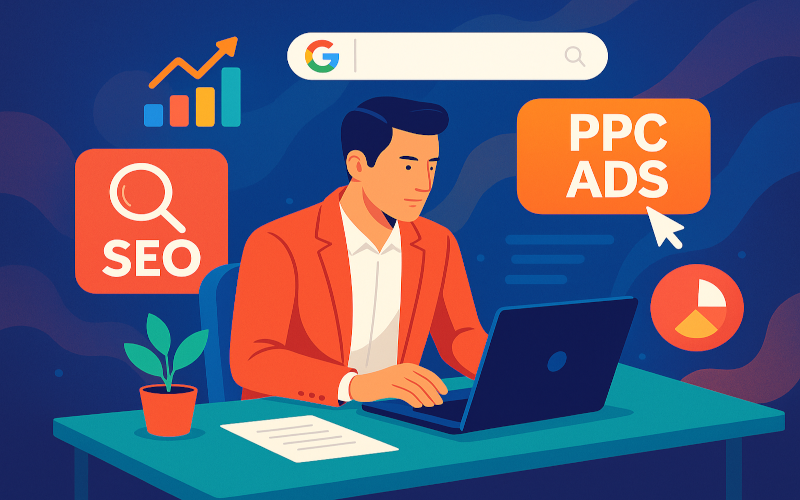Best Search Engine Marketing Strategy: SEO & PPC Tips Every Business Needs in 2025
This post may contain affiliate links, including Amazon links. As an Amazon Associate, we earn from qualifying purchases.
October 1, 2025 - Reading time: 36 minutes
Discover the best search engine marketing strategy for 2025. Learn practical SEO tips, PPC advertising strategies, and step-by-step methods to grow your business online.

Search engine marketing can feel like a storm rolling in, you know, loud, unpredictable, and a little scary. Between endless advertising options, new algorithms every other week, and complicated advice that sounds more like rocket science than business, it’s easy to get overwhelmed.
But here’s the truth: search engine marketing (SEM) doesn’t need to be complicated. At its core, it’s about showing up where your customers are already looking and making sure they see you before they see the competition.
In this guide, I’ll break it down into four simple, practical steps you can use to build or evaluate your SEM strategy. No fluff. No hype. Just what works.
1. Define the Real Purpose of Your Website
Forget buzzwords and consultant talk about “setting SMART goals.” Ask yourself the one question that actually matters:
“What is the purpose of my website?”
Most businesses land in one of three camps:
-
To sell products or services directly
-
To generate leads for the sales team
-
To educate and build authority with your audience
Your answer drives every other SEM decision you’ll make. If your site exists to sell, your SEM strategy should lean heavier on product-focused ads and optimized sales funnels. If it’s about lead generation, then keywords, content, and PPC ads need to build trust and capture emails. If it’s about educating, then high-quality blog content and SEO take the driver’s seat.
👉 For example, if you run an online store, you might use tools like Wondershare for creating video content that drives product demos or VectorStock for professional images to improve your landing pages. Both help your website purpose shine.
2. Build a Search Engine Marketing Plan That Works
SEM works because it puts you right in front of people when they’re actively searching for what you offer. That’s powerful. But don’t overthink it. There are only two main roads you need to focus on:
-
Search Engine Optimization (SEO): Showing up in the “free” organic results.
-
Pay-Per-Click Advertising (PPC): Showing up in the paid ad slots.
Both have their place. SEO builds long-term traffic you don’t pay for every click on. PPC gets you quick visibility like flipping on a light switch but you pay for every visitor.
If you’re new, you can even learn SEM basics affordably through platforms like Lead Academy or Transformative Learning, which offer structured courses to help entrepreneurs cut through the noise.
The winning formula is balance. Use PPC for fast wins and targeted campaigns while investing in SEO for steady, compounding growth over time.
3. Do Search Engine Optimization (the Right Way)
SEO gets a bad rap because of two extremes: “snake oil” salesmen promising instant rankings and overly technical experts drowning you in jargon. The truth is simpler.
SEO is about building a website that search engines and humans trust.
Here are some SEO basics every site should lock in:
-
Write unique, descriptive page titles (keep them under 60 characters for Google).
-
Write meta descriptions that summarize each page in under 160 characters.
-
Use keywords naturally in headings and throughout the text.
-
Add ALT text to images that describe what’s shown.
-
Make sure your site loads fast, looks good on mobile, and follows modern web standards (W3C compliant).
👉 Tools like CorelDraw can help create professional graphics for blog posts, while SEO plugins can make sure every page follows these guidelines.
Once those basics are in place, you can level up with more advanced tactics like keyword targeting, link building, blogs, and analytics tracking. But never skip the basics because they’re the foundation.
4. Use Pay-Per-Click Ads to Boost Visibility
PPC advertising is like renting a billboard on the busiest digital highway. You pay for every click, but when managed well, it can deliver an excellent return on investment.
Here’s what it boils down to:
-
Pick the right keywords – Think like your customer. Use keyword tools to find terms that are searched often but match closely to your business. Example: “Keen sandals” is far better than just “sandals.”
-
Set smart bids – Start small. Use Google Ads’ keyword planner or traffic estimator to set competitive bids without blowing your budget.
-
Write ad copy that grabs attention – Headlines win clicks. Use power words like “Best,” “Ultimate,” or number lists (“Top 5”) to spark curiosity. Then back it up with clear, compelling ad text.
👉 Want to manage PPC like a pro? Try using marketing software from ETax or other trusted SEM merchants in your affiliate list to track conversions and budgets in real-time.
The secret is to test, track, and tweak. Don’t just “set it and forget it.” Watch what’s working and double down.
Search engine marketing doesn’t have to be complicated or scary. Keep it simple:
-
Define your website’s purpose.
-
Build a balanced plan with SEO and PPC.
-
Nail the SEO basics before chasing advanced tactics.
-
Use PPC smartly for quick wins and targeted reach.
When you do this, SEM stops being some overwhelming tech jungle and starts being what it should be, a reliable engine that drives leads, sales, and authority for your business.
